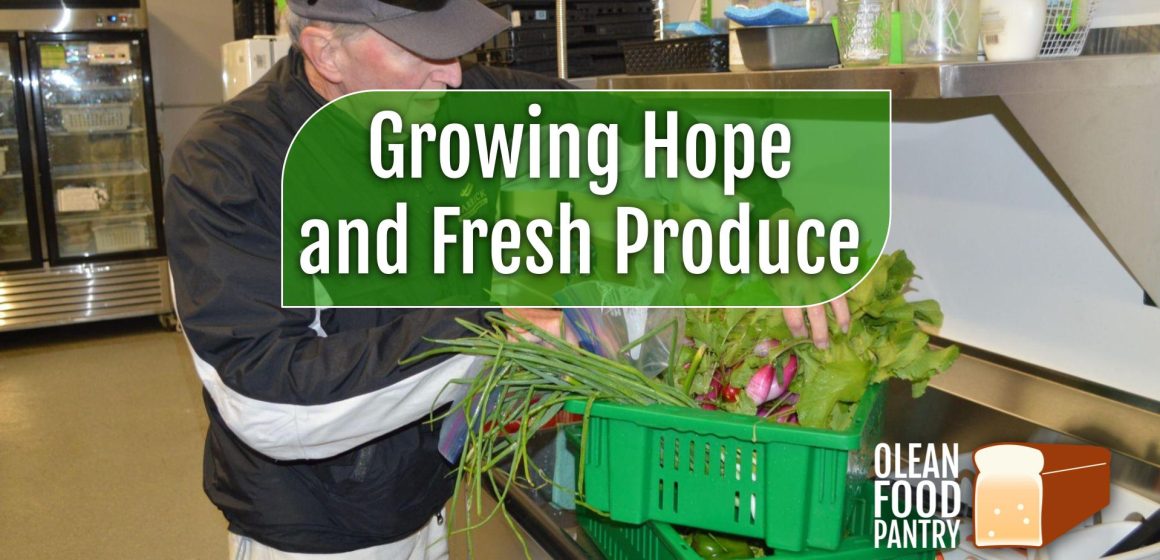10 Challenges to Ending Global Food Insecurity by 2030
That always seems to be the lofty goal, right? End some big issue by the end of the decade. Those who profess themselves to be changemakers on a global scale always seem to kick the can a decade into the future – ending global food insecurity is no different – so the goals inevitably won’t be met and the world can focus on the next decade.
(Don’t believe us? There was most certainly an Ending Global Food Insecurity by 1980 campaign, too.)
Yet we’re still here, fighting the good fight. Here at the Olean Food Pantry, ending global food insecurity by ourselves is beyond our reach. But we try – and we try hard – to address hunger in our own communities. That’s the key. Rather than a top-down approach requiring massive amounts of systemic change coordinated amongst hundreds of nations, a bottom-up approach making incremental changes one community at a time is the only feasible solution.
Viewed through a small, local lens, the challenges to ending global hunger appear less daunting. In this blog, we address those complexities expressed in a report by the UN Food & Agriculture Organization (FAO) and offer some proactive solutions.
Ending Global Food Insecurity Begins Community By Community
Changing can come only by a culmination of a multitude of grassroots efforts. One community becomes 10, which becomes 100, which becomes 1,000 – and so on. The blueprint for successfully addressing hunger on a large scale echoes impactful approaches championed by small community organizations just like the Olean Food Pantry, emphasizing the profound change that can be achieved when communities come together.
1. Global Population Surge
The exponential growth in the world’s population, set to eclipse 10 billion by 2050, necessitates localized solutions. Community-based initiatives are crucial to adapting food production and distribution methods specific to challenges presented by urbanization and shifting demographics.
Communities themselves must organize to develop sustainable agricultural practices. By fostering local farming initiatives and community-supported agriculture programs, both urban and rural areas can ensure food self-sufficiency. Additionally, empowering communities with education on resource efficiency and supporting local farmers through incentives will create a more resilient food system capable of withstanding the demands of a burgeoning global population.
2. Bridging the Financial Gap
To eliminate hunger by 2030, the UN says an additional $265 billion per year would be required. But entire nations couldn’t possibly throw money in the pot and say, “Mission accomplished!”
Strategic investment at the grassroots level eliminates wasteful spending and stretches the dollar further. At the Olean Food Pantry, cash donations allow us to purchase 66% MORE food than by nonperishable donations alone. Beyond relying solely on government aid or large-scale international funding, fostering local philanthropy is paramount in encouraging individuals and businesses to invest in community-based initiatives.
3. Tailoring Solutions for Hunger Hotspots
Persistent hunger hotspots demand targeted, community-centric solutions. Local organizations, intimately acquainted with the specific needs of their communities, play a pivotal role in addressing the root causes of hunger. As we always say, we KNOW the people we serve. We understand their struggles and the distinct socioeconomic difficulties they face daily.
Building a comprehensive network of local initiatives involves collaboration among community leaders, nonprofits, government bodies, wealthy philanthropists and average donors alike. By harnessing local knowledge and expertise, these initiatives can implement sustainable solutions that address the nuanced causes of food insecurity, ranging from economic disparities to environmental realities.
It’ll take the synergy of local insight, collaborative action and tailored interventions to overcome barriers to ending global food insecurity.
4. Agricultural Expansion & Deforestation
This concept may seem foreign to people in our rural Western New York communities, where forests and agricultural tradition abound. But the climate crisis, urbanization and deforestation threaten ecosystems everywhere. We rely on those ecosystems to produce stable crops each year.
Local farmers must stand with environmentalists and policymakers to establish guidelines that encourage agricultural growth without compromising environmental integrity. One approach is to promote and implement agroforestry practices, integrating trees and crops on the same land. This not only enhances biodiversity, but also contributes to soil health and water conservation.
By fostering a shared understanding of the delicate balance between agricultural needs and ecological sustainability, communities can work toward solutions that not only address immediate food security concerns but also ensure the long-term health of the planet.
5. Agriculture-Related Water Scarcity
If you haven’t guessed, so many of the practices meant to improve the cultivation of food can actually threaten sustainability. Agriculture consumes 70% of global freshwater resources. Local communities must adopt sustainable water management practices. Initiatives at the grassroots level can alleviate water scarcity, ensuring the equitable distribution of this precious resource.
Additionally, fostering collaborations between communities, agricultural experts and water resource management authorities is essential. A proactive approach not only addresses immediate challenges, but also establishes a foundation for resilient agricultural systems that can withstand future uncertainties related to water availability.
6. Preventing Land Degradation
Land degradation affects one-third of farmlands globally, threatening the ongoing production of food resources and representing a significant challenge to ending global food insecurity. Addressing this demands a nuanced understanding of local conditions and sustainable farming practices to restore and protect local lands. Adopting agro-ecological methods like cover cropping and agroforestry improve soil fertility and prevent erosion.
Local communities can engage in reforestation projects, creating green belts that act as natural barriers against land degradation. Furthermore, educational programs focused on sustainable land management can empower farmers to implement practices that regenerate soil health.
7. Eliminating Carbon Emissions
Once again, industrial processes for the mass production of food can cause more damage than good. Reducing global-warming causing emissions from agriculture should be a top priority at local and regional levels. Communities can become advocates for environmentally friendly farming, leading the way in mitigating our carbon footprint.
Additional agro-ecological methods like precision and organic farming can significantly reduce greenhouse gas emissions. Moreover, community-led initiatives can promote the use of renewable energy sources in farming operations, transitioning away from conventional methods. Educational programs within local communities can raise awareness about the environmental impact of various farming techniques, encouraging farmers to adopt eco-friendly practices.
8. Developing Climate-Smart Practices
The uncertainties of climate change should give us all pause to consider the resilience of local food systems. While attempting to slow – or stop – climate change, we must also factor the importance of climate-smart agricultural practices tailored to regions.
Community-driven initiatives can focus on diversifying crop varieties, promoting drought-resistant plants to ensure food resilience. Collaboration with local farmers, research institutions and environmental organizations can develop and share knowledge about climate-resilient farming techniques.
9. Meeting Escalating Food Demand
If ever there was a call to pioneer innovative growing practices, the world will need to produce at least 50% more food to feed all people in the coming decades. One reality associated with widespread urbanization will be the necessity of urban farming and community gardens, which will allow localized food production and reduce the environmental footprint of long-distance transportation.
Investing in farming and gardening education programs within our communities can empower average citizens with the skills to implement advanced, sustainable growing methods.
10. Tackling Food Waste
Last, but certainly not least, we must address food waste. Simply put, as a global society, we waste FAR TOO MUCH! Addressing the mind-blowing 1.3 billion tons of food lost or wasted annually requires community-driven changes in consumption habits, distribution networks and waste-reduction strategies.
We must begin setting an example for global sustainability. Communities can establish food recovery programs that connect local businesses, farms and households with excess food to those in need. Collaborating with local schools, governments and businesses, localities can learn practices and implement policies that incentivize responsible food production and consumption to make conscious choices in their daily lives.
Can We End Global Food Insecurity? The Answer Begins Locally
The journey to end global food insecurity by 2030 necessitates a community-first approach. When communities unite, they become formidable forces capable of driving meaningful change and potentially ending global food insecurity for good.
As we confront these challenges, remember that the power to end hunger lies within grassroots efforts – one impactful step at a time. You can begin in our Western New York community by becoming an impact investor in the Olean Food Pantry.





Did You Know? Cash Donations Help Your Local Food Pantry Serve More – Olean Food Pantry
March 5, 2024 @ 8:55 pm
[…] food insecurity is a reality around the world, the way it is experienced varies community by community. We know from experience that the Olean […]
It’s Hunger Action Month at Olean Food Pantry – Olean Food Pantry
September 11, 2024 @ 4:54 pm
[…] Action Month, celebrated by local food pantries and food banks around the world. While the focus is on a global scale, ours is a grassroots mission that begins by tackling food insecurity in our rural communities. We […]
Healthcare Providers & Food Insecurity: Opportunities for Collaboration – Olean Food Pantry
May 22, 2025 @ 4:08 pm
[…] care providers at all levels have a great opportunity to fight food insecurity everywhere and improve health outcomes for their patients in […]